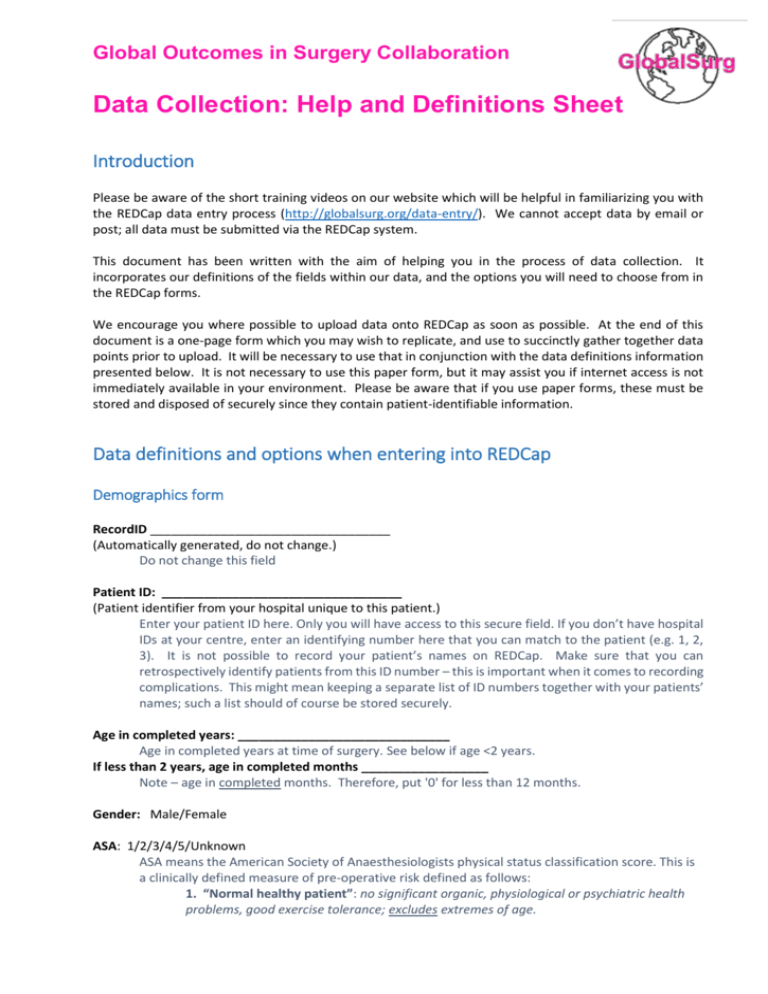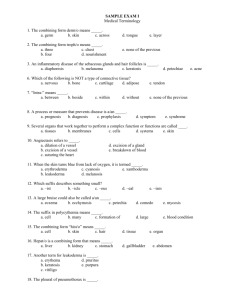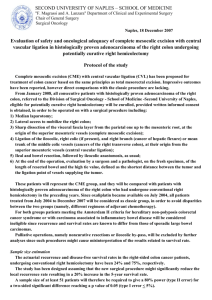Help - Globalsurg
advertisement

Global Outcomes in Surgery Collaboration Data Collection: Help and Definitions Sheet Introduction Please be aware of the short training videos on our website which will be helpful in familiarizing you with the REDCap data entry process (http://globalsurg.org/data-entry/). We cannot accept data by email or post; all data must be submitted via the REDCap system. This document has been written with the aim of helping you in the process of data collection. It incorporates our definitions of the fields within our data, and the options you will need to choose from in the REDCap forms. We encourage you where possible to upload data onto REDCap as soon as possible. At the end of this document is a one-page form which you may wish to replicate, and use to succinctly gather together data points prior to upload. It will be necessary to use that in conjunction with the data definitions information presented below. It is not necessary to use this paper form, but it may assist you if internet access is not immediately available in your environment. Please be aware that if you use paper forms, these must be stored and disposed of securely since they contain patient-identifiable information. Data definitions and options when entering into REDCap Demographics form RecordID __________________________________ (Automatically generated, do not change.) Do not change this field Patient ID: __________________________________ (Patient identifier from your hospital unique to this patient.) Enter your patient ID here. Only you will have access to this secure field. If you don’t have hospital IDs at your centre, enter an identifying number here that you can match to the patient (e.g. 1, 2, 3). It is not possible to record your patient’s names on REDCap. Make sure that you can retrospectively identify patients from this ID number – this is important when it comes to recording complications. This might mean keeping a separate list of ID numbers together with your patients’ names; such a list should of course be stored securely. Age in completed years: ______________________________ Age in completed years at time of surgery. See below if age <2 years. If less than 2 years, age in completed months __________________ Note – age in completed months. Therefore, put '0' for less than 12 months. Gender: Male/Female ASA: 1/2/3/4/5/Unknown ASA means the American Society of Anaesthesiologists physical status classification score. This is a clinically defined measure of pre-operative risk defined as follows: 1. “Normal healthy patient”: no significant organic, physiological or psychiatric health problems, good exercise tolerance; excludes extremes of age. 2. “Patient with mild systemic disease”: Well-controlled disease with no functional limitations- such as diabetes mellitus without complications; cigarette smoking without complications; mild obesity; pregnancy. 3. “Patient with severe systemic disease”: Disease with no immediate threat to life, such as stable angina, chronic renal failure, poorly-controlled hypertension. 4. “Patient with severe systemic disease that is a constant threat to life”: At least one severe poorly controlled disease- such as severe emphysema, symptomatic heart failure or unstable angina. 5. “Moribund patient not expected to survive without the operation”: Examples: haemodynamically unstable due to trauma or sepsis; multiorgan failure. History of diabetes: No/ Diet controlled/ Tablet controlled/ Insulin controlled/ Unknown Smoking status: No, never/ Yes, but stopped now/ Yes, current smoker/ Unknown Emergency computed tomography (CT) scan performed?: Yes/ No If no CT performed, why not?: CT not clinically indicated/ CT clinically indicated but unavailable If CT indicated but unavailable, why?: No CT scanner in this hospital/ CT scanner present but electrical supply unavailable/ CT scanner present but not working/ CT scanner present but no reporting service available/ CT scanner present but patient unable to pay for CT/ Other reason Operation form Date of operation: _____________________ (DD-MM-YYYY format) Time of start of operation (time of knife-to-skin): 0800-1800 (daytime)/ 1800-2200 (evening)/ 2200-0800 (night-time) Time from hospital admission to knife-to-skin: Time of admission refers to the patient’s first contact with hospital, whether that was through an Emergency Department or directly with surgical services. This may be determined by direct observation, clinical notes, or admission records. < 6 hours/ 6-11 hours/ 12-23 hour/ 24-47 hours/ 48+ hours Surgical safety checklist used?: This relates to the use of the WHO surgical safety checklist, or an equivalent team based surgical safety checklist. Usage can be confirmed by direct observation or clinical notes. Yes/ No, not available in this hospital/ No, but available in this hospital Training of most senior surgeon present?: Details entered here should relate to the most qualified or experienced surgeon who was physically present within the operating room (scrubbed or unscrubbed) for part or all of the operation. Medically-qualified surgical specialist/ Medically-qualified non-specialist/ Non-doctor surgical specialist/ Non-doctor and non-specialist Experience of most senior surgeon present?: Again, the details entered here related to the experience of most senior surgeon present – see definition above. Less than 5 years since finishing medical school*/ 5 years or more since finishing medical school* (* or equivalent undergraduate/training course if non-doctor) Training of most senior anaesthetist present?: In different parts of the world, many different professionals can give an anaesthetic and in some settings the operating surgeon may also administer the anaesthetic. Details entered here should relate to the most qualified or experienced anaesthetist who was physically present within the operating room for part or all of the operation. If the surgeon administered the anaesthetic, state “no anaesthetist”. Medically-qualified anaesthetic specialist/ Medically-qualified non-specialist/ Non-doctor anaesthetic specialist/ Non-doctor and non-specialist/ Not applicable, no anaesthetist Experience of most senior anaesthetist present Less than 5 years since finishing medical school?: See explanation above. Less than 5 years since finishing medical school*/ 5 years or more since finishing medical school*/ Not applicable, no anaesthetist (* or equivalent undergraduate/training course if non-doctor) Anaesthetic type: General anaesthetic/ Spinal anaesthetic/ Local anaesthetic +/- sedation (e.g. ketamine) Incision: Please avoid using the ‘other’ option unless necessary. If more than one incision made, record the larger of the two incisions. Midline/ Transverse/ Rooftop/ Right subcostal (Kocher)/ Right iliac fossa (Gridiron/Lanz)/ Paramedian/ Laparoscopic (+/- open specimen extraction)/ Laparoscopic converted to open/ Other (please specify) Primary operation performed: Record the main procedure performed. It is not possible to enter more than one operation type. Abdomen: Laparotomy with no other Colon: Total excision of colon and rectum/ procedure/ Colon: Total excision of colon/ Abdomen: Diagnostic laparoscopy with no other Colon: Extended excision of right hemicolon/ procedure/ Colon: Excision of right hemicolon/ Abdomen: Division of adhesions of peritoneum/ Colon: Excision of transverse colon/ Abdomen: Repair of anterior abdominal wall/ Colon: Excision of left hemicolon/ Abdomen: Closure of gastroschisis/exomphalos/ Colon: Excision of sigmoid colon/ Oesophagus: Excision of oesophagus/ Colon: Other excision of colon/ Oesophagus: Repair of oesophagus/ Colon: Reduction of intussuception/volvulus Oesophagus: Other open operations on without excision/ oesophagus/ Colon: Formation of any colonic stoma/ Stomach: Total excision of stomach/ Colon: Other open operations on colon/ Stomach: Partial excision of stomach/ Rectum: Excision of rectum/ Stomach: Connection of stomach to jejunum/ Rectum: Fixation of rectum for prolapse/ Stomach: Operations on ulcer of stomach/ Rectum: Other open operations on rectum/ Stomach: Other repair of stomach/ Liver: Partial excision of liver/ Stomach: Incision of pylorus/ Liver: Repair of liver, including liver packing/ Stomach: Other open operations on stomach/ Liver: Other open operations on liver/ Duodenum: Operations on ulcer of duodenum/ Gallbladder: Excision of gall bladder/ Duodenum: Correction of malrotation/ Gallbladder: Other open operations on gall Duodenum: Other open operations on bladder/ duodenum/ Bile duct: Repair of bile duct/ Small bowel: Excision of small bowel/ Bile duct: Incision of bile duct/ Small bowel: Bypass of small bowel/ Bile duct: Other open operations on bile duct/ Small bowel: Excision of Meckel's diverticulum/ Pancreas: Excision of head of pancreas/ Small bowel: Reduction of intussuception Pancreas: Open drainage of lesion of pancreas/ without excision/ Pancreas: Other open operations on pancreas/ Small bowel: Formation of ileostomy/ Spleen: Total excision of spleen/ Small bowel: Closure of perforation/ Spleen: Other open operations on spleen/ Small bowel: Other open operations on small Aorta/vessels: Any primary abdominal vascular bowel/ operation/ Appendix: Emergency excision of appendix/ Kidney: Total excision of kidney/ Kidney: Partial excision of kidney/ Kidney: Open repair of kidney/ Kidney: Other open operations on kidney/ Ureter: Repair of ureter/ Ureter: Other open operations on ureter/ Bladder: Repair of bladder/ Bladder: Other open operations on bladder/ Uterus: Abdominal excision of uterus/ Uterus: Other open operations on uterus/ Ovary: Bilateral excision of ovary / tube/ Ovary: Unilateral excision of ovary / tube/ Ovary: Other open operations on ovary / tube/ Diaphragm: Repair of rupture of diaphragm/ Diaphragm: Other operations on diaphragm/ Other abdominal procedure (please specify) Bowel resection performed?: Only record as “yes” if complete transection through bowel lumen. If appendix alone removed, answer "no". No/ Yes - handsewn anastomosis/ Yes - stapled anastomosis (+/- handsewn reinforcement)/ Yes - stoma without anastomosis Stoma formed? Note that if a mucous fistula is made in addition to any category, this does not need to be recorded. No/ Loop ileostomy/ Loop colostomy/ End ileostomy/ End colostomy/ Other Diagnosis: Record the single main cause leading to surgery. This should be recorded with reference to operative findings; and in some cases in may be necessary to await pathological or other investigations before recording. Neoplasm: any malignant (cancer) Adhesions: no bowel obstruction Neoplasm: any benign Intestinal obstruction: Adhesions Infection, Typhoid / paratyphoid Intestinal obstruction: Intussusception Infection, Other infectious gastroenteritis /colitis Intestinal obstruction: Volvulus Infection: HIV disease Cholelithiasis / cholecystitis (gallstones) Infection: other Acute pancreatitis Trauma: non-penetrating / blunt Female reproductive: Salpingitis/oophoritis Trauma: penetrating Female reproductive: Abnormal uterine/vaginal Perforation of oesophagus bleeding Peptic ulcer: bleeding Female reproductive: Ectopic pregnancy Peptic ulcer: perforation Female reproductive: Obstetric trauma Peptic ulcer: bleeding and perforation Female reproductive: Post-partum haemorrhage Peptic ulcer: without bleeding or perforation Congenital: Pyloric stenosis Appendicitis Congenital: Diaphragmatic hernia Hernia: any abdominal hernia Congenital: Meckel diverticulum Colitis/gastroenteritis: Crohns disease Congenital: Gastroschisis Colitis/gastroenteritis: Ulcerative colitis Congenital: Other Colitis/gastroenteritis: Other noninfective inc. Complication of previous surgical operation ischemic bowel /procedure Bleeding: small bowel / colon with no No disease identified (negative laparotomy) malignancy Other diagnosis (please specify; please try to Diverticular disease avoid using) Stercoral perforation of colon Was perforation of an abdominal organ found at operation?: Yes/ No Do not include perforations which are sustained during the course of the operation Supplementary oxygen used?: No, oxygen not available/ No, but oxygen available/ Yes, via bottle or mains supply/ Yes, via oxygen concentrator Pulse oximeter used during surgery? No, not available/ No, but available/ Yes If a pulse oximeter is used by anaesthetist or surgeon during the entire procedure, this should be recorded as “yes”. If not used, or used for only part of the procedure, this should be recorded as “no”. Prophylactic antibiotics given? Prophylactic refers to antibiotics given either at induction, or during surgery but before opening of a contaminated space (e.g., before bowel resection). No, not available/ No, but available/ Yes Whole blood or blood product(s) used? This question relates to use at any point in this hospital stay (pre-operatively on this admission, or intra-operatively or post-operatively on this admission). Whole blood use indicates transfusion of all (unseparated) blood components, often from an on-site donor. “Blood product(s)” refers to use of a separated blood component (e.g., packed red cells, fresh frozen plasma). Where both whole blood and blood products are used, state “whole blood”. No, but available in this hospital/ No, not available in this hospital/ Yes, whole blood/ Yes, blood products (e.g. packed red cells, plasma, platelets) Thromboembolic prophylaxis used? Drug prophylaxis includes unfractionated heparin and low-weight molecular heparin. Mechanical prophylaxis includes use of stockings and intermittent pneumatic compression stockings intraoperatively. No/ Yes, drug only/ Yes, mechanical only/ Yes, drug and mechanical/ Yes, other Follow-up form 24-hour mortality: Alive/Dead This is our study’s primary endpoint, investigators are expected to go to the ward and review each patient 24 hours after the end of surgery to determine whether they are dead or alive. This must be completed for every patient. Please note that 24-hour mortality includes death during surgery. 30-day mortality: Alive: confirmed at 30 days/ Alive at discharge, full 30-day follow-up not available/ Died We accept that not all hospitals participating in GlobalSurg will have access to follow-up data when patients are discharged. If the patient is alive at the time of discharge and no follow-up is available, an appropriate option is available. However, if it is possible to check alive/dead status at 30 days following discharge, this should be done. If a patient dies more than 30 days after the operation, they are recorded as alive (we are recording mortality status at 30 days). Re-intervention required within 30 days? This relates to surgical, endoscopic or radiological re-intervention, by Day 30. The entry field allows which method used to be specified. No/ Yes, endoscopic/ Yes, interventional radiology/ Yes, theatre, local anaesthetic/ Yes, theatre, general anaesthetic/ Unknown Complication leading to critical care admission within 30 days of primary operation?: If critical care was used in a planned way (not due to a complication), this question should be answered as “no”. For the GlobalSurg study, “critical care” is defined as a ward or other setting where there is an enhanced level of nursing or medical care and is usually better equipped than a general ward. A critical care setting will involve intravenous infusions running overnight, regular checks of clinical observations (normally every 1-2 hours) and may have availability of oxygen. No/ Complication requiring critical care occurred, but facilities unavailable/ Yes/ Unknown Complication not resulting in critical care, re-intervention or death within 30 days of primary operation?: Yes/No This refers to minor complications requiring medication but not surgery, endoscopy, radiological intervention or critical care. Examples are: surgical site infection treated with antibiotic (should also be recorded below), wound infection opened at bedside, myocardial infarction treated medically, deep venous thrombosis treated with heparin, pneumonia or urinary tract infection treated with antibiotics, ileus, thrombophlebitis. Length of stay after surgery (whole days): ___________________ Day of surgery is day 0; Leaving blank indicates unknown; Maximum value is 30 days (for 30 days or beyond). For example, staying from Monday to Friday counts as a 4-day length of stay and “4” should be entered. Anastomotic leak: No/ Yes/ Anastomosis not performed An anastomotic leak diagnosed clinically/symptomatically, radiologically, and/or intra-operatively. Wound infection: Yes/ No Defined by any one of: (1) Purulent drainage from the incision (2) At least two of: pain or tenderness; localised swelling; redness; heat; fever; AND the incision is opened deliberately to manage infection or the clinician diagnoses a surgical site infection (3) Wound organisms AND pus cells from aspirate/swab Intra-abdominal/pelvic abscess: Yes/ No Detected clinically/symptomatically, radiologically, or intra-operatively. Global Outcomes in Surgery Collaboration OPERATION – REDCap form 2 Pulse oximeter?: _____________________ Data Collection Form http://globalsurg.org Oxygen used?: ______________________ Date: _______________(dd-mm-yyyy) Prophylactic Abx?: ____________________ Time of knife-to-skin: _________________ Blood products?: _____________________ Time delay (admission – start): ______________ VTE prophylaxis?: _____________________ Checklist?: ________________ Complete this form with reference to the data definitions and REDCap fields explained above. Note that this data can alternatively be entered directly onto REDCap. DEMOGRAPHICS – REDCap form 1 FOLLOW-UP – REDCap form 3 Senior surgeon training: ___________________ Senior surgeon experience: __________________ 24-hr mortality?: ____________ Senior anaesthetist training: _________________ 30-day mortality?: _______________ Senior anaesthetist experience : ______________ 30-day re-intervention – if so, what?: _____________________________________ Patient ID: ____________________________ Anaesthetic type: _______________ Age: _________ Incision: ____________________ Gender: ________ Primary operation: _______________________ ASA: _______ _______________________________________ Diabetes?: __________________ Bowel resection/anastomosis?: _______________ Smoking?: __________________ Stoma?: ___________________________ CT performed?: __________________ Diagnosis?: ____________________________ If not, why not?: ___________________ ______________________________________ Complication leading to critical care?: _____________________________ Complication – not leading to critical care?: _____________________________ Length of stay?: ________________ Anastomotic leak?: _______________ Wound infection?: ____________ Abdo/pelvis abscess?: ________________ Pre-op perforation?: ___________________ Note to users: This form records patient-identifiable information and should be kept in a secure location, then destroyed appropriately once data uploaded onto REDCap.








